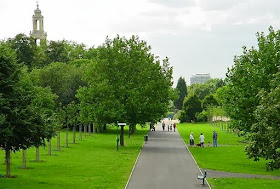This may interest only me…
Four weeks ago my son left home and moved
into a flat in Southwark. After the long walk from London Bridge tube station to
his new abode, my appetite was whetted to investigate the
history of this part of South London.
 |
| My son's new home- a converted Victorian pub 'The Duke of York'. |
The history of Southwark predates the
Norman Invasion and it appears King Cnut granted Earl Godwin a third of the
profits taken the river trade (the king had the other two-thirds). But Godwin’s rites lapsed after his death and his successive generations more or less
constantly petitioned the crown for restoration of this valuable privilege.
From the 1100’s to the 1500’s a variety of noblemen coveted the tolls and taxes
raised from traffic on the Thames. But by the 1550’s King Edward VI had largely
absorbed Southwark into the city of London and put it under the same rule of
law as the rest of the capital.
 |
| Southwark - south of the Thames |
In Georgian times people were in no
hurry to live on what was an area of marshy scrubland. However, industry
flourished on the banks of the Thames – powered by water mills. The area was
especially well-known for leather production but tanneries used dog faeces and
human urine for part of the process and emitted vile fumes. Indeed, the south
bank of the Thames was described as ‘hideous’
with ‘dank tenements, rotten, wharves and
dirty boat houses.’
 |
| Borough market - circa 1860 |
In 1622 the leather dressers of
Southwark petitioned against the damage done to their trade by an influx of
Dutchmen leather workers who did not serve that same apprenticeship and undercut their prices.
Up to about 1780 the built up parts of
Southwark centred on the south end of London Bridge and the rest of the borough
was relatively rural, encompassing an area of land on the south side of the
Thames including Borough, Bermondsey and
Bankside. The latter, Bankside, was the traditional home of bear-baiting, and
although this cruel sport was banned under the Puritan’s with the Restoration
the Bankside Bear Garden was resurrected. However, Borough had a gentler
reputation - for trading in fruit and veg.
 |
| Borough Market in the modern day |
Borough Market sold market-garden
produce grown in Kent and Surrey. Not to be outdone Southwark was also famous
for hot house fruits. In 1755 an article in the London World notes:
‘Through
the use of hothouses…every gardener that used to pride himself in an early cucumber
can now raise a pineapple.’ Borough
Market still exists to this day – as does another vibrant place of outdoor
commerce, East Street Market (which is near my son’s flat) and sells everything
from cutlery to bowls of fresh fruit, and second hand clothing to fake perfume.
 |
| Southwark Fair by Hogarth - 1733 |
In Georgian times Southwark held a fair so well-known that it caught the interest of William Hogarth. His etching
of Southwark Fair is evocative of the lively, bawdy atmosphere and denotes some
of the local characters. Can you spot the famous gingerbread seller, Tiddy
Doll? (He wears a hat with an enormous feather and gold lace banding.) Tiddy
was such a character that James Gillray also recorded him in a print ‘Tiddy-Doll the great French
Gingerbread-maker, drawing out a new batch of Kings.’ Apparently Tiddy was so popular he leant his name to a number of London eating houses - the last of which closed in Mayfair in the late 1990's.
 |
| Gillray's depiction of Tiddy Doll |
As to modern times? Much of the area is
undergoing redevelopment, as shown by the lovely Burgess Park with its lake,
barbecue areas and skate park. The atmosphere is relaxed and the people
friendly, and I can’t wait to explore further – including the nearby area of
Vauxhall… (More of this another time.)
 |
| Burgess Park |

Interesting post! I think you might mean Edward VI, not Edward IV though.
ReplyDeleteOh dear, putting my I's before my V's! Thanks for spotting that Poppy and hope you enjoyed the rest of the post.
DeleteG x
Would not recommend cutting through Aylesbury estate at night. Use OKR. Stay safe
ReplyDeleteThanks for the advice - will pass it onto my son.
DeleteG x
Loved it! Thanks for sharing this fascinating history.
ReplyDeleteSo interesting!
ReplyDelete